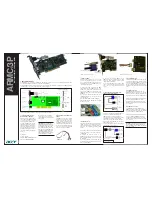
514 Configuring and monitoring FICON Extension Services
FICON emulation requirement for a determinate path
FICON emulation processing creates FICON commands and responses on extended FICON Channel Path
IDs (CHPIDs), and must know exactly what exchanges are occurring between a Channel and a control unit
(CU) on a CHPID to function correctly. For FICON Emulation processing to function correctly, the responses
to Host I/O (channel I/O) must be carried on the same ISL as the commands.
There are three ways to ensure a determinate path for FICON commands and responses:
•
Define only one IP route and one FCIP tunnel between sites.
•
Use a traffic isolation zone (TI zone) to ensure that there is only one path across an ISL or FCIP Tunnel
between an ingress and egress FICON port.
•
For HP StorageWorks M-series directors (6140 and i10K directors), implement the Allow/Prohibit
feature.
One Ethernet interface, one IP route and one FCIP tunnel between sites
You can ensure a determinate path for FICON commands and responses by configuring only one Ethernet
connection between the 400 MP Router SAN routers or B-Series Multi-Protocol Router Blades using only
one IP route and one FCIP tunnel.
Traffic isolation zoning
The Traffic Isolation feature may be used to control the flow of interswitch traffic through the 400 MP Router
SAN router or B-Series Multi-Protocol Router Blade VE_Port or E_Port connections. This feature can be used
with Allow/Prohibit settings on M-series directors to create complete flow through paths between end
points connected through M-series and Fabric OS products. Traffic isolation uses a special zone, called a
traffic isolation (TI zone), to create dedicated paths for specific traffic. You can create a TI zone from either
the command line, as described in ”
Installing and maintaining firmware
” on page 213, or from Web Tools.
Allow/Prohibit for M-series directors
The Allow/Prohibit feature is available on the Mi10k and 6140 M-series directors. This feature enables you
to control traffic flow between F_Ports and E_Ports. It is implemented from the Mi10K or M6140 Director
Element Manager GUI through use of an Allow/Prohibit matrix. The matrix allows you to block (prohibit)
specific F_Port to E_Port connections. You can create a determinate data path by blocking all F_Port to
E_Port connections except the one you want to use for FICON traffic.
Figure 86
shows a portion of the
allow/prohibit matrix. The F_Port addresses are in the vertical column to the left, and the E_Port addresses
are in a horizontal row at the top. In the portion shown, F_Port address 04 can connect to E_Port 07. All
other connections are prohibited, as indicated by the universal prohibited symbol.
Figure 86
Allow/Prohibit example
See the
Brocade Mi10K or M6140 Director Element Manager User Manual
for specific information about
implementing the allow/prohibit feature.
FICON emulation concepts and features
FICON emulation supports FICON traffic over IP WANs using FCIP as the underlying protocol. FICON
emulation can be extended to support performance enhancements for specific applications through use of
the following licensed features.
•
XRC emulation
•
Tape write pipelining
•
Tape read pipelining
Summary of Contents for A7533A - Brocade 4Gb SAN Switch Base
Page 1: ...HP StorageWorks Fabric OS 6 2 administrator guide Part number 5697 0016 Edition May 2009 ...
Page 24: ...24 ...
Page 99: ...Fabric OS 6 2 administrator guide 99 ...
Page 100: ...100 Managing user accounts ...
Page 118: ...116 Configuring standard security features ...
Page 164: ...162 Configuring advanced security features ...
Page 234: ...232 Installing and maintaining firmware ...
Page 268: ...266 Administering advanced zoning ...
Page 284: ...282 Configuring Enterprise class platforms ...
Page 292: ...290 Routing traffic ...
Page 294: ...292 Interoperability for merged SANs ...
Page 302: ...300 Configuring the Distributed Management Server ...
Page 334: ...332 iSCSI gateway service ...
Page 340: ...338 Administering NPIV ...
Page 407: ...Fabric OS 6 2 administrator guide 405 ...
Page 408: ...406 Using the FC FC routing service ...
Page 438: ...434 Administering extended fabrics ...
Page 460: ...456 Administering ISL trunking ...
Page 516: ...512 FICON fabrics ...
Page 526: ...522 Configuring and monitoring FICON Extension Services ...
Page 540: ...536 Configuring the PID format ...
Page 544: ...540 Understanding legacy password behavior ...
Page 546: ...542 Mixed fabric configurations for non merge SANs ...
Page 550: ...546 Migrating from an MP Router to a 400 MP Router ...
Page 558: ...554 Inband Management ...
Page 572: ...568 ...
















































